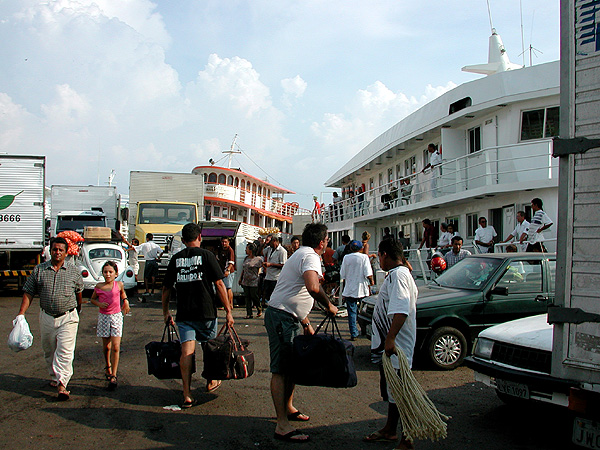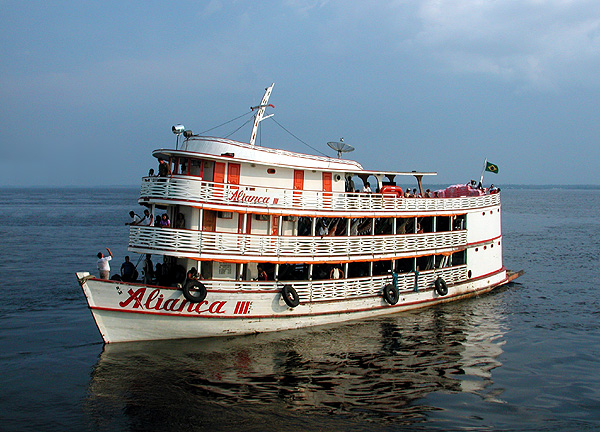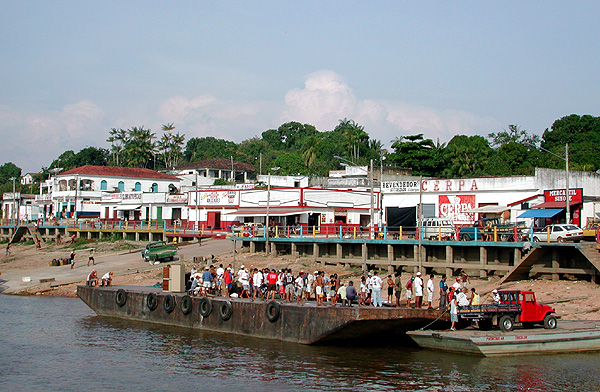On the afternoon of the 18th, we set sail from Manaus on the Navio Santarém, a river boat fifty paces long by 8 paces wide. The boat is modern, clean, and well-run. It also features a bar, restaurant, and central air conditioning. Onboard are several hundred men, women, and children, most living on two open hammock decks.
The boat is stratified much like society. At the top are the suites. These are cabins with a single, slightly-wider bed, a foyer, and a head. The head includes a flush toilet, sink, and overhead shower. The entire suite is perhaps 10 feet square. There are 7 of these.
The next deck down contains double cabins. These are similar to the suites, but don’t include a foyer. The double cabins include two bunk beds rather than a single, wider bed. There are 11 of these.
The next deck is the enclosed hammock deck. This is a single large space, with hooks built into the ceiling. Everyone on this deck brings their own hammock, which they hang on a convenient hook. There is a row of bathrooms along each side of the deck, but otherwise there is little privacy. The hammocks are mostly one up against the next. There are about 100 strung up four hammocks across.
At night the air conditioning is unnecessary, and the windows are opened to either side to allow fresh air to flow through. During the day the windows are closed to give people a respite from the heat.
The very bottom deck is what we called ‘steerage’. This is the non-air-conditioned hammock deck. It’s very similar to the deck above, and just as crowded. It’s basically at water level, and waves sometimes wash over the rail and onto the deck.
The bottom deck also includes the ship’s bar. It’s at one end of the deck, so that you can drink and look out over a hundred hammocks. Some contain babies, some couples, some old ladies. Below the hammocks are the owner’s posessions. The shipping company tries to minimize theft on the hammock decks by leaving the overhead lights on all night.
If you wish to travel in hammock class, you need a way to secure your belongings. Most of the people never leave their hammock except to eat and use the bathroom. You need to be able to sleep in an open space with a hundred other people, including crying babies. You need to be able to sleep with a 100-watt light bulb overhead. And you need to be able to sleep through being kicked by a dreaming neighbor.
Hammock class sounded romantic to me, but I like privacy and space. I’ve got a private stateroom on the top deck of the ship. The price (US$300) includes three meals a day. I also think that this is the best, most ‘native’ way to travel through the country. There’s a wonderful cross-section of Brasilian society on the boat. Hippy Brasilians smoke grass on the aft deck, and a huge speaker blasts out music from noon to midnight. Kids run around everywhere expelling huge amounts of energy. Couples make out on the unlit fore deck at night.
About a half-hour outside of Manaus, we came to the famous meeting of the waters, where the Rio Negro joins the Rio Solimões to form the Amazon River. The Rio Negro is (as you would expect) black. The froth at the bow of the boat looks like Coca-Cola. The Rio Solimões is a light brownish-yellow. When they flow together, they’re slow to mix, and the dividing line between the two different waters is very stark.
Our first stop is Parintins, a small town on the south bank. Folks from town come down to the dock selling all sorts of things. For a dollar, I buy a slice of cheese roughly the size and weight of a discus. It’s sitting on the bench in my cabin. I really have no interest in eating it. I just think it looks cool.
On Thursday we stop at Juruti, and I decide to climb out onto the dock. There are very few safety regulations in evidence. Folks climb up and down the side of the boat and leap from the ship to the dock and back. No one (including the crew) bothers to put up the gangway. While standing on dock, I buy a bag of donuts from one of several kids selling them. I also buy one for Shay.
Just before we leave, a motorcycle is loaded onto the steerage deck. It’s a beautiful bike, a cruiser with lots of chrome. Six men lift it up and carry it gently over the rail and into the boat.
As we pull away I hear several splashes from the direction of the docks. I look, but I can’t see anything in the muddy water but ripples. Then one small head pops out of the water, followed by three more. The boys who were selling food on the docks are taking a break in the river.
Thursday night we stop at Obidos, located at the narrowest and deepest part of the Amazon. The federal police want to check everyone’s passports, so we wait here while they go through the ship. They look through mine, stopping only to read the Venezuelan stamps.
While we’re waiting to leave, the entire town of Obidos goes dark. A few people on the boat laugh and applaud, but those standing on dock aren’t surprised. After a little while, candles start to be lit, and the 42,000 residents adapt. When we pull out a half-hour later, the power is still out.
When I awake on Friday, we’re stopped in the port of Santarém, about halfway between Manaus and Belém. Santarém is a small city of about 250,000 located at the meeting of the yellow Amazon and dark green Tapajós rivers. Offshore, I can clearly see the line where the two waters have not yet mixed.
If we had chosen to do so, it would have been possible to drive south from Santarém. Brasil route 163 heads south from Santarém to Rurópolis, where it meets the transamazônica. Instead we’re heading east to the more populated coast.
We left Santarém at 6pm on Friday, just as the sun was setting. Once again the engines are thrumming. Once again we’re going down river. The stars overhead are unfamiliar, and the air ahead is dizzying with a scent like ripe fruit.
Ron



